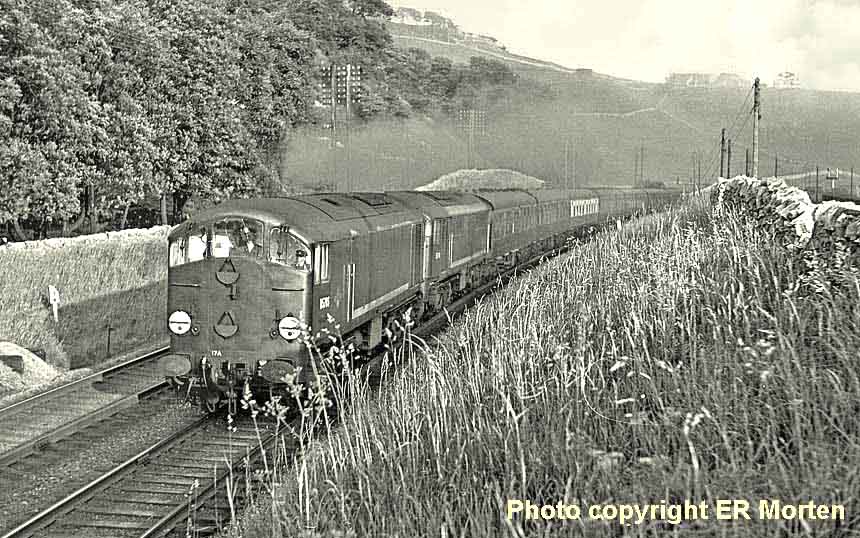Railway enthusiasts fall into two categories: the self-confessed romantic, who long for the days when life seemed so much simpler then, and the unsentimental scholar, whose interest in railways is firmly rooted in the historical and technical side. I have tried to strike a happy balance between both sides on this website,  because no matter where one's allegiances lay, trains and railways are more than just a mode of transport to us, they are a lifelong passion. Being a stauch steam fan, however, I'm bound to be a little prejudiced but having taken a long hard look at the British Transport Commission's (BTC's) Modernisation Plan of 1955, it reveals a number of strategies that are now widely regarded as being fundamentally flawed, therefore this page is strictly for the scholarly diesel fans...
because no matter where one's allegiances lay, trains and railways are more than just a mode of transport to us, they are a lifelong passion. Being a stauch steam fan, however, I'm bound to be a little prejudiced but having taken a long hard look at the British Transport Commission's (BTC's) Modernisation Plan of 1955, it reveals a number of strategies that are now widely regarded as being fundamentally flawed, therefore this page is strictly for the scholarly diesel fans...
 In order to shed some light on the post-war Fifties, we must go back to 1954 when the Minister of Transport gave British Railways approval for the introduction of eight 2-car diesel railcar units on the local rail services between Leeds Central, Bradford Exchange and Harrogate in April 1954. The 'Derby Lightweights' (a nickname coined by the use of a light alloy and steel in their construction at the Derby Carriage & Wagon Works) were the true forerunners of the first-generation diesel fleet, and I mention them here because their introduction was coincident with the BTC's pilot scheme diesel programme in the Modernisation Plan. At the same time, Rolls Royce's thrust-measuring rig, dubbed 'The Flying Bedstead', was flown for the first time. The jet pipes of two Nene engines were angled downwards at 90° to give the vehicle a vertical thrust and this ultimately led to the launch of the RAF's famous Harrier Jump Jet some twenty-odd years later. (Top Right) Derby Lightweight vehicle No 79035 is mounted on a plinth at the country's national pride event - the Royal Festival Hall at Battersea in May 1955. The second shot shows the 'Flying Bedstead' being put through its paces in August 1955.
In order to shed some light on the post-war Fifties, we must go back to 1954 when the Minister of Transport gave British Railways approval for the introduction of eight 2-car diesel railcar units on the local rail services between Leeds Central, Bradford Exchange and Harrogate in April 1954. The 'Derby Lightweights' (a nickname coined by the use of a light alloy and steel in their construction at the Derby Carriage & Wagon Works) were the true forerunners of the first-generation diesel fleet, and I mention them here because their introduction was coincident with the BTC's pilot scheme diesel programme in the Modernisation Plan. At the same time, Rolls Royce's thrust-measuring rig, dubbed 'The Flying Bedstead', was flown for the first time. The jet pipes of two Nene engines were angled downwards at 90° to give the vehicle a vertical thrust and this ultimately led to the launch of the RAF's famous Harrier Jump Jet some twenty-odd years later. (Top Right) Derby Lightweight vehicle No 79035 is mounted on a plinth at the country's national pride event - the Royal Festival Hall at Battersea in May 1955. The second shot shows the 'Flying Bedstead' being put through its paces in August 1955.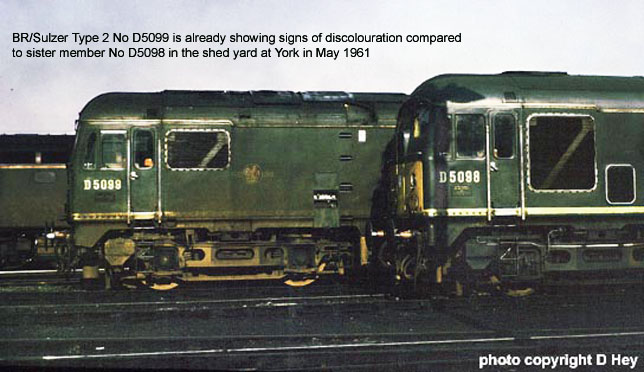
During the Fifties, Britain was stony broke - it had been since early in the war. The emergency conditions imposed by the Government to keep in check the chronic wartime shortage of essential materials continued long after hostilities ceased, although evidence of a post-war revival began when the Labour Government made a start on demolishing our crumbling Victorian cities, the most evocative images being the slum clearance programme and the construction of 'pre-fab' housing.
When the Tories came to power, the BTC was given financial backing for building a new-image British Railways, the hypothesis being that a Modernisation Plan would turn BR's thumping annual losses into a healthy profit. Costing £1.2bn, spread over fifteen years, the principle aim was to breathe new life into a state-owned rail system struggling to recover from the ravages of World War Two, therefore work began on the construction of modern stations, new marshalling yards, track and colour light signalling - and, much to the chagrin of steam fans, an intrinsic part of the plan (in keeping with the modern look) was the decision to replace BR's old-fashioned fleet of steam engines with modern diesel and electric traction.
And that, I have to say, is a moot point, because even today, the row over whether steam's early demise was entirely justified remains unresolved. Indeed, die-hard steam fans will argue that whilst investment of any kind was worthy of praise, by putting the 'diesel cart' before the 'steam horse', British Railways finished up with a motley collection of bits and pieces, rather than one satisfying whole, which served only to deepen our cynicism over BTC's rose-tinted vision for the future. Nonetheless, by 1956 the task of revitalising Britain's ailing railways was getting into its stride, albeit using the same strategy and seemingly driven by the same desire to replace anything regarded as old and outdated. Invitations were sent out to various British manufacturers to build 174 new diesel locomotives, made up of three different power groups; the largest being a Type 'C' locomotive of 2,000hp and over for heavy main line work (later designated Type 4), followed by a Type 'B' locomotive design of between 1,000-1,250hp for mixed traffic work (later Type 2) and Type 'A' machines of 800- 1,000hp for freight duty, later classified as Type 1.
For serious students of the BTC's 1955 Modernisation Programme, I do recommend visiting the 'BR/Sulzer Type 2 Class 24/25' website compiled by David Hills. In recognition of its historical content, the site is being archived by the UK Web Archiving Consortium - very well deserved, if you ask me! Click here for link
(Below) The graph gives some idea of the different locomotives ordered in the original 1955 Modernisation Plan. After the plan was announced, however, the BTC revised its original power classification, changing the Type A 800-1,000hp freight locomotives, Type B 1,000-1,250hp mixed traffic and Type C locomotives of 2,000hp upwards for heavy duty to the following: Type 1 (up to 1,000hp) Type 2 (1,000-1,499hp) Type 3 (1,500-1,999hp) Type 4 (2,000-2,999hp) and Type 5 (3,000hp upwards). To add further complications to the BTC's pilot scheme designs, the initial order was followed by orders for basically similar locomotives in the production fleet, which gave rise to many generic types for what was intended to be a standard design. As a result, the diesel classes became sub-divided by reasons of changes in power output, electrical equipment, and coupling systems variations as construction proceeded. For example, the first 151 locomotives of the BR/Sulzer Type 2 Bo-Bo 1,160hp D5000's were powered by a Sulzer 6LDA-28 engine and classified as Class 24 in the TOPS re-numbering scheme. The remaining locomotives were fitted with the more powerful Sulzer 6LDA-28B engine developing 1,250hp and were classified as Class 25. Similarly, the Brush Type 2 A1A-A1A D5500's were fitted with the Mirrlees engines became Class 30, while the re-engined machines using EE Co power units became known as Class 31s, subsequently sub-divided as Class 31/0 electro-magnetic-control, Class 31/1 - electro-pnuematic control; and 31/4 for those locomotives fitted with electrical train heating (ETH) equipment.
In 1955, it was planned that 80 locomotives would go to the Eastern Region, 65 to the London Midland Region, and 29 was to be shared between the Southern and Western Regions. The BTC expected that a series of comparative road tests over a three year period would determine BR's future operating requirements. Sadly, the plan didn't quite work out that way, for in an attempt to reverse BR's plummeting finances (a £16.5 million deficit in 1956 increasing to £48.1 million in 1958) a decision was taken to accelerate the elimination of steam as a panacea. At the beginning of 1959, out of the 174 pilot scheme diesel locomotives ordered, only 140 had been delivered, yet a further order for 900 was placed before the manufacturer's designs had been fully evaluated. This headlong rush to get rid of steam led to BR's heterogeneous collection of new diesel locomotives being acquired by a completely irrational process and, without the benefit of full prototype trials, several early types were quickly eliminated from BR stock. First, we take a look at the Type 1 and 2 pilot scheme diesel locomotives...the Type 4 designs appear on the following page.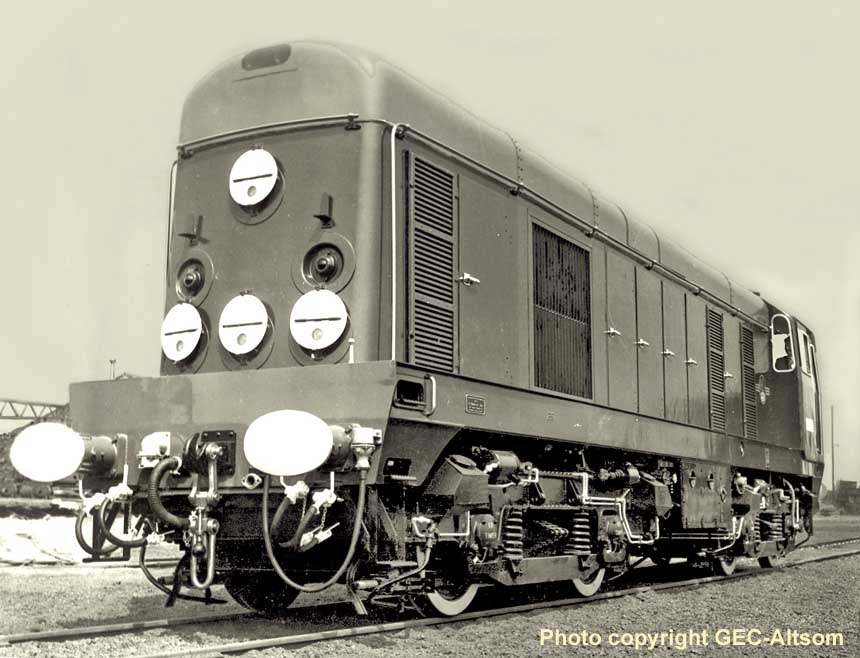
(Above) When the BTC announced its plan to evaluate the new diesel types under service conditions, the English Electric Company (EE Co) had a long history in rail traction - the EE Co supplied its first diesel engine to a British railway company in 1934 for use in a 350hp shunter - and by 1955 the firm had grown considerably, taken in by amalgamation with several locomotive builders including the Vulcan Foundry at Newton-le-Willows and the Teesside-based Robert Step henson & Hawthorn. This gave the conglomerate the vast manufacturing capacity to deal with the first 20 pilot scheme Type 1 Bo-Bos Nos D8000-19 in 1957. The EE Co used a variant of their K type engine for its 1,000hp Type 1 Bo-Bos, retaining the 'V' form and designating it 8SVT Mk11. The modest size of the engine enabled the makers to construct a 'hood' type locomotive with the bodyside inset along the length of the running plate. Although less glamorous than its larger EE Co relatives in the Type 3-5 power range, the Type 1 was an attractive piece of industrial design. Painted in BR Brunswick Green livery for the main body, with a medium grey roof over the bonnet and cab, black undergear, red bufferbeams and polished handrails and trim.
(Below) The second of the batch, No D8001, runs round its coaching stock at Penrith before the resumption of WCML acceptance trials in July 1957. The first locomotive, No D8000, had already been formally handed over on June 3rd 1957. The 20 Types 1s Nos D8000-19 were allocated to Devons Road depot in East London. Photo © GEC-Alstom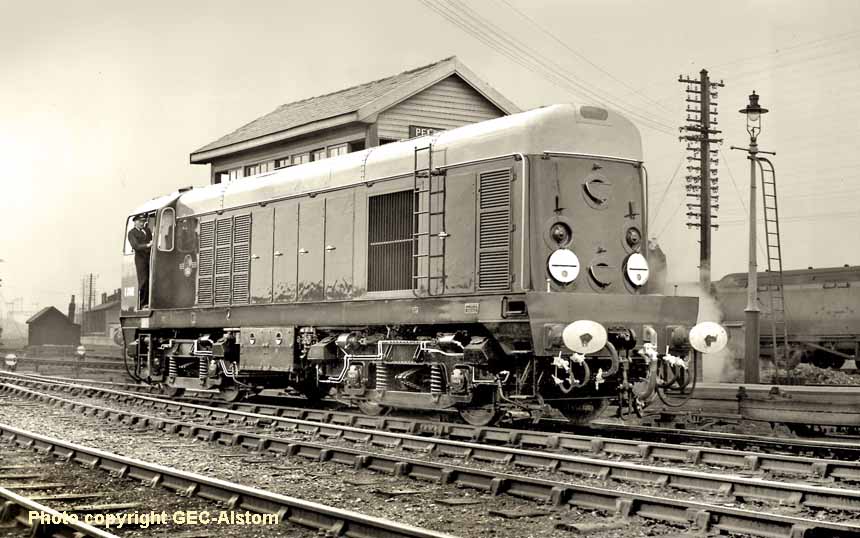


(Above-Below) Since the completion of WCML electrification, this view of Basford Hall yard - and, for that matter the EE Co Type 1 Bo-Bos - are now but just a memory. Here, with less than a year of revenue-earning service behind them, a pair of pilot scheme Type 1s Nos D8003 and D8005 is coupled as a 2,000hp unit on August 16th 1958. During early dieslisation, British Railways had a predominance of locos in the 1,000/1,250hp range and relatively few in the 2,000hp group therefore the EE Co Type 1s were working in multiple almost from new. Although the No 2 end of the single-cab locomotive was officially regarded as the rear, the practise of working nose-to-nose was adopted early on as it gave drivers improved visibility. (Below) With the 'D' prefix removed (and full yellow ends in place of the rectangular warning panels) veteran pilot scheme No 8018 is paired with the first production EE Co Type 1 D8020 at Morpeth on July 17th 1970. The Type 1s are working a coal train from the north for the Blyth & Tyne line which will necessitate reversal. Note the oval buffers and blue star code above the buffer beam.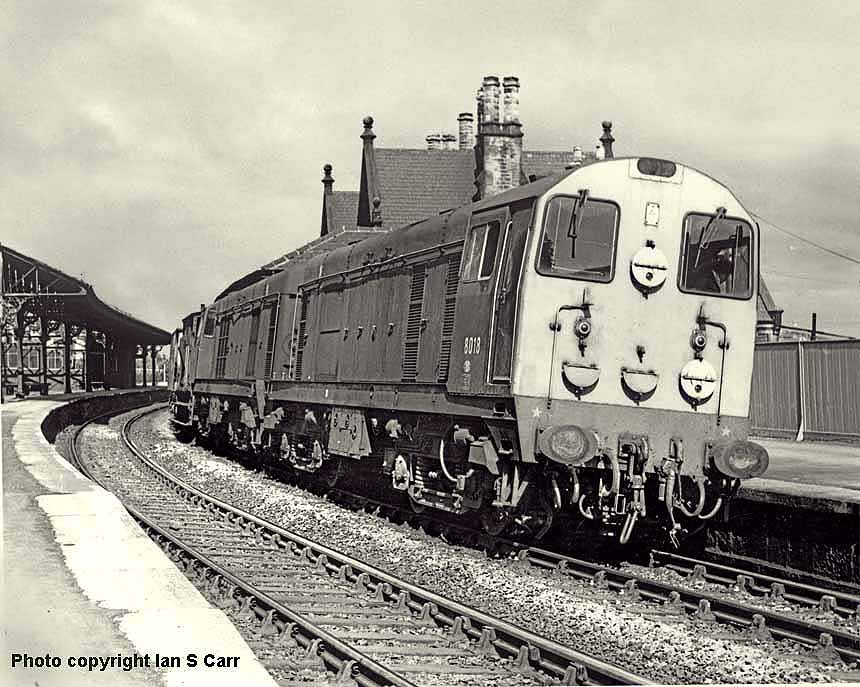

(Above-Below) In November 1957, the EE machines were joined by ten British Thompson-Houston 800hp Type 1 Bo-Bos Nos D8200-D8209 at Devon Roads depot (1D) - the first purpose-built diesel maintenance depot on BR - followed by ten North British D8400s allocated to the ER based at Stratford in July 1958. When the pilot scheme was abandoned, the BTH company received a contract for a further 34 locomotives. They were powered by the Paxman 16HXL engine, which proved unsatisfactory in service, requiring excessive maintenance, and the single-cab design gave drivers restricted forward vision along the bonnet and, to some extent, the rear. The livery was dark green with pale blue/grey cab ends and red bufferbeams, whilst the bogies and undergear were painted black. Still in grey undercoat, one of the British Thomson-Houston production Bo-Bos, No D8213, hauls three mobile test vehicles past Buxton East during a road test programme over the MR line between Derby and Manchester on December 8th 1958. The driver of No D8202 looks happy to pose for the official photographer at Rugby in the second shot. Photos: © ER Morten, GEC/Alstom
Another major player was the Brush Falcon Works based at Loughborough. Established in 1851, the company had absorbed several firms, notably Mirrlees and the industrial locomotive builders Bagnalls, which gave the Falcon works the capacity to build twenty locomotives in the Type 2 category; the specification being for a double-cab mixed traffic locomotive (fitted with train heating equipment) and designated the diesel equivalent of the LNER B1s and LMS Black 5s. The Brush Type 2 A1A-A1A was largely modelled on the 25 locomotives built for the Ceylon Government Railways, although the six-wheeled bogies (the inner pair were unpowered) was altered to British standard gauge, combining a leaf and helical springing to improve suspension and ease the axle load. During construction of Nos D5500-19 (TOPS Class 30) additional orders were placed with the company that culminated in a production run of a total of 263 locomotives (Class 31) all built to the same basic design, but with the Mirrlees engine uprated to 1,365hp, together with a change-over from the electro-magnetic multiple-unit coupling system to the standard electro-pneumatic (Blue Star) system making the class compatible with most other manufacturers designs at that time. By the end of 1957, the Brush Type 2s were working on the Eastern Region, followed in March 1958 by the arrival of ten new EE Co Type 4 D200s, shared between Stratford and Hornsey depots. 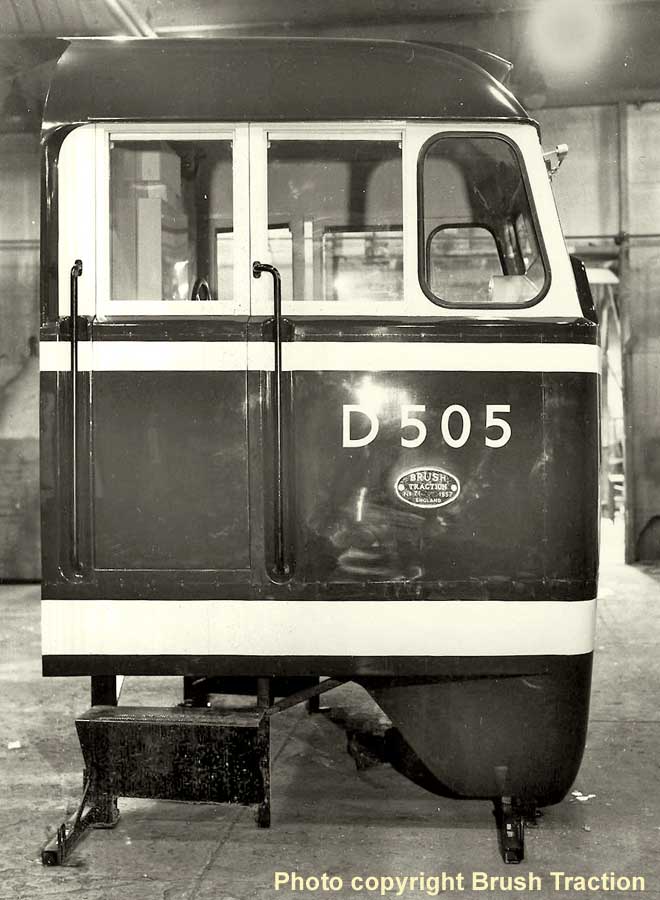
(Above-Below) Prior to construction of the Brush Type B pilot scheme locomotives, the BTC appointed a team of design consultants to advise the company on appearance and livery. A full-size timber mock-up of  the cab was constructed at the works for scrutiny by footplatemen and shed staff, and to allow the designers to make the necessary modifications which inevitably followed evaluation of a new locomotive design by railmen. The BTC stipulated that gangway doors should be incorporated in the front end to allow for crew movement between locomotives when working in multiple, however the provision of doors intruded upon the windscreen area. A neat solution was found by using a 3-piece windscreen with angled edges picked out in eggshell blue (off-white). The livery was standard BR Brunswick green with two bands of lining running the full length of the bodyside and around the front ends. The roof was mid-grey and the bogies black. The second view of the assembly line in 1957 shows the initial batch in various stages of construction. The first, No D5500, is in the centre. The signs read - British Railway 20 Type 2 locomotives. Contract No 0445100, and target date for test. No D5500 was handed over to the BTC on 31 October 1957, and hauled its first revenue-earning train from Liverpool St to Clacton on 13 November.
the cab was constructed at the works for scrutiny by footplatemen and shed staff, and to allow the designers to make the necessary modifications which inevitably followed evaluation of a new locomotive design by railmen. The BTC stipulated that gangway doors should be incorporated in the front end to allow for crew movement between locomotives when working in multiple, however the provision of doors intruded upon the windscreen area. A neat solution was found by using a 3-piece windscreen with angled edges picked out in eggshell blue (off-white). The livery was standard BR Brunswick green with two bands of lining running the full length of the bodyside and around the front ends. The roof was mid-grey and the bogies black. The second view of the assembly line in 1957 shows the initial batch in various stages of construction. The first, No D5500, is in the centre. The signs read - British Railway 20 Type 2 locomotives. Contract No 0445100, and target date for test. No D5500 was handed over to the BTC on 31 October 1957, and hauled its first revenue-earning train from Liverpool St to Clacton on 13 November.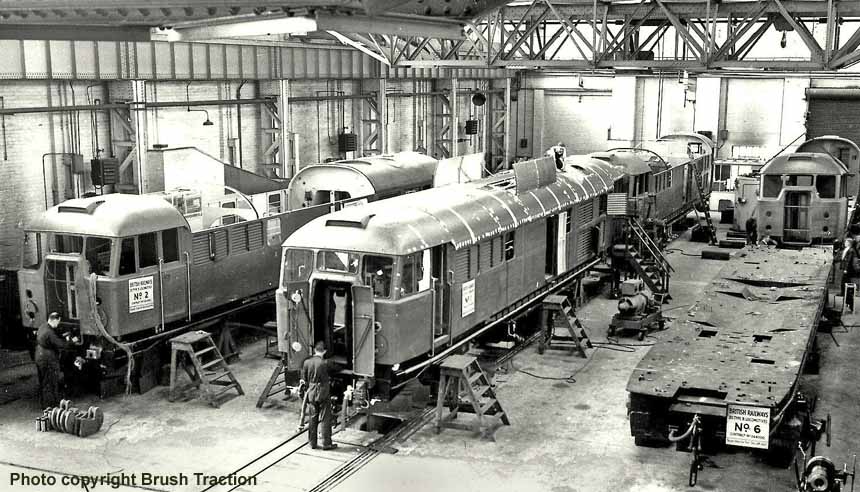


(Above-Below) The Brush Type 2 A1A-A1A was largely modelled on the 25 locomotives built for the Ceylon Government Railways, with the six-wheeled bogies (the inner pair were unpowered) altered to British standard gauge. The bogie combined a leaf and helical springing to improve suspension and ease the axle load, which gave the locomotive the widest possible route availability throughout the BR network. Still in brown undercoat, the first of the company's twenty pilot scheme Type 2, No D5500, is on a test run from Derby to Chinley on October 10th 1957. The test equipment was sited in one end cab and the locomotive had to be turned on the Chinley turntable before returning to Derby. 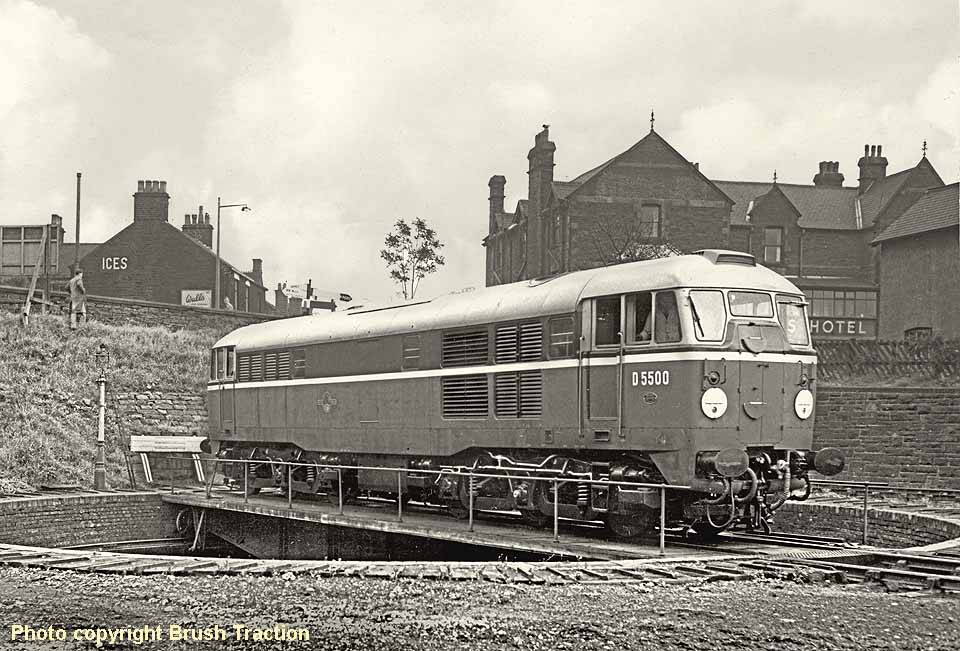

(Above-Below) These are just two of the evocative images of BR's new diesel era which are available from the archives of the National Railway Museum. (Below) A railwayman is refuelling Class 31 No D5513 at Ripple Lane diesel maintenance depot, London, 4 April 1960. The NRM's Imagination Works project contains a huge photo collection of British Railways digital imagery; a visit to the 'Liverpool Street Photos' page here is highly recommended… links can be found on the NRM's website that will take you to an extensive collection of railway travel posters and other images from the Science Museum Group here.
(Below) The success of the pilot scheme Brush Type 2 led to the production of a further 243 locomotives built of the same basic design, except the Mirrlees engine was uprated to 1365hp and the electro-magnetic control system was changed to the standard 'Blue Star' electro-pneumatic arrangement, enabling the fleet to work in multiple with a wide range of other BR diesels.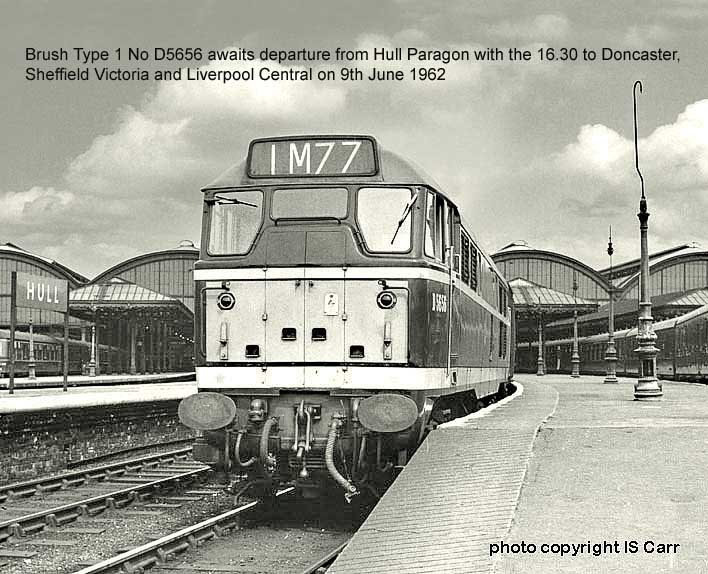
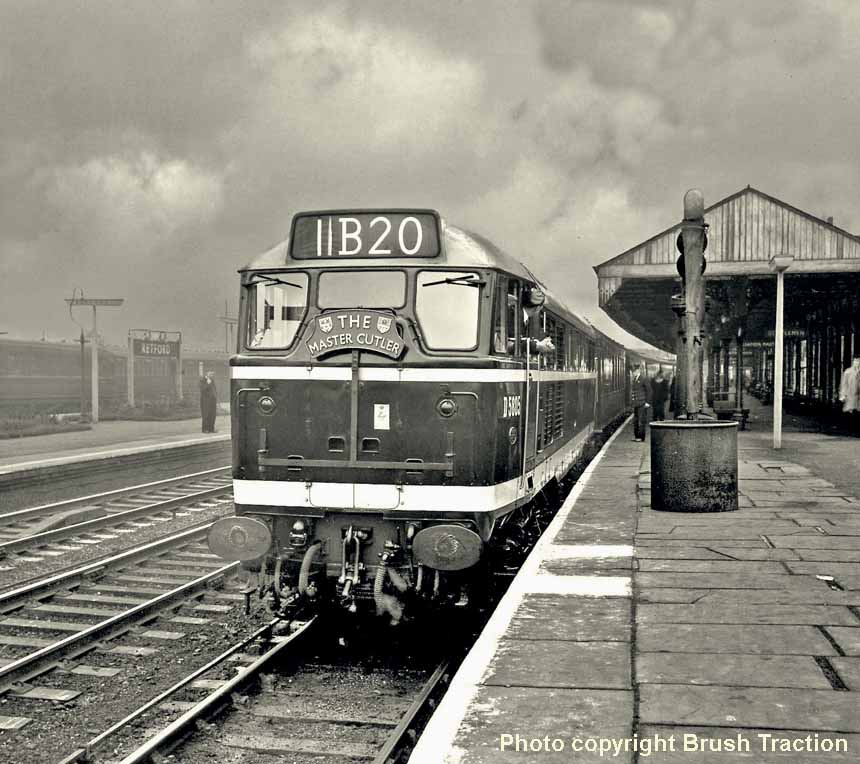
(Above) Following abolition of the headcode disc system for train identification, four-character headcode boxes began to appear on the cab roofs on the 243 production machines, but supply problems saw this modification fitted at random sequences during construction and old-style roofs continued to appear on some locomotives, dubbed 'Skinheads' by enthusiasts. The ER fitted brackets onto the lamp irons of their allocation to allow a named train headboard to be carried. Here the driver of No D5805 awaits the right away with the 07.20 Sheffield Victoria-London Kings Cross 'Master Cutler' at Retford on November 16th 1961. Photo: © Brush Traction.

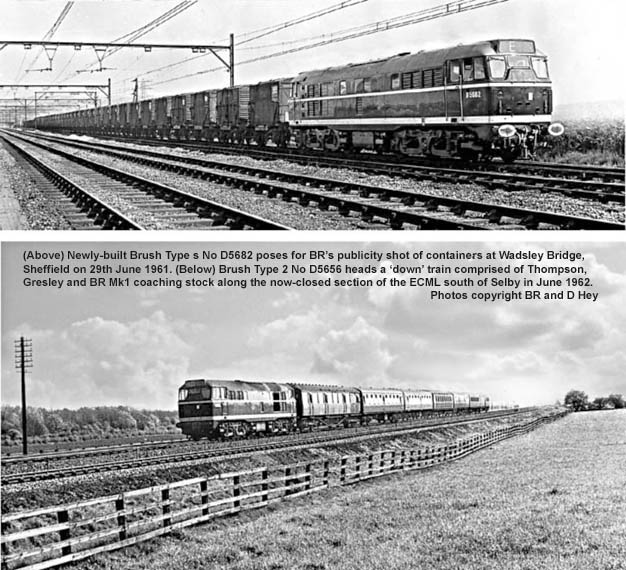
(Below) Fresh off the assembly line at the Brush Falcon Works, No D5862, TOPS No 31327, poses for the official photographer outside the Brush Works in October 1962. D5862 spent the majority of its working life on the East Coast Main Line and its branch lines, and was also used on suburban services out of Kings Cross. Ousted from passenger duties by more modern traction, the locomotive's steam-heating boiler was stripped out prior to taking up duties on BR Parcels Train services. During its time with BR, D5862 carried a number of liveries, including BR Green, BR Blue and Railfreight Grey. Withdrawn from service in 1996, D5862 was offered for sale by EWSR after privatisation of the UK rail industry. The locomotive was purchased by George Littlejohn in 2001, and subsequently moved to the Strathspey Railway.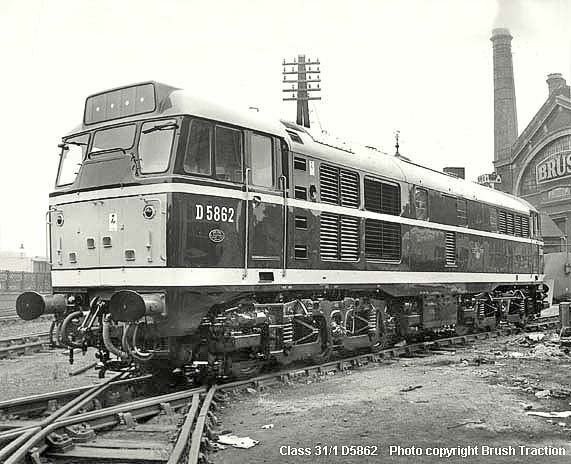
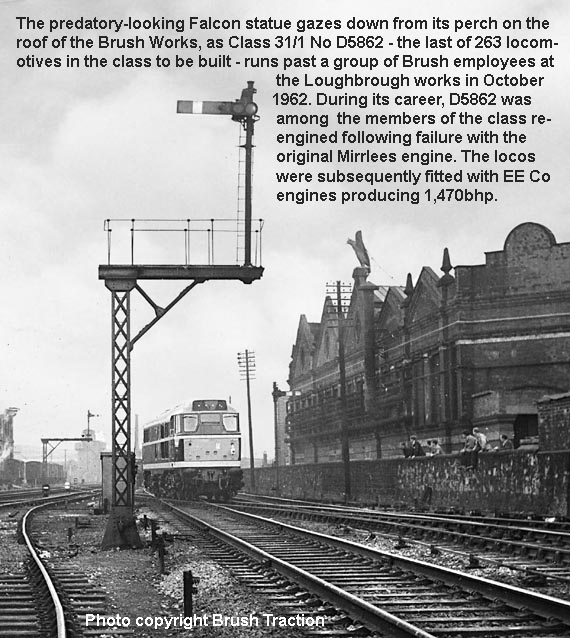
(Above) The World Wide Web is a major source of reference that draws thousands of enthusiasts every day, either to research a subject or to bring with them their own diverse interests and expertise; indeed the subject of trains and railways is extremely complex and so it is essential to get the facts right. Among the most prolific contributors to spot inaccuracies is ex-BR Fleet Engineer, Vic Smith, who was among the group of staff standing on strategically-placed wooden pallets (above right) to get the best view over the wall on 25th October 1962. When not at Technical College, Vic spent most lunchtimes during his apprenticeship waiting for the acceptance trial test trains to pass by from Derby. He never imagined that a couple of years later he would be riding by in the cabs of the new Brush 47s.
(Below) Meanwhile, mention must be made of the troublesome Metro-Vick 1,200hp Co-Bos (later TOPS Class 28) which were introduced on the former MR route between St Pancras and Manchester Central in 1958. Constructed at the Metropolitan Vickers/Beyer Peacock works at Stockton-on-Tees, the Co-Bos were powered by Crossley 2-stroke engines of 1,200hp - which, the makers claimed could produce a higher power from each of its eight cylinders than the conventional turbo- charged four-stroke engines adopted by other manufacturers for their pilot scheme designs. Theoretically, a two-stroke engine is capable of producing a higher power at every revolution, because during the 2-stroke cycle, each cylinder generates power at every revolution of its crankshaft whereas the power from a 4-stroke engine is produced from alternative revolutions. Sadly, the Crossley engine was largely responsible for the Co-Bos inauspicious and very short careers, and the design was not perpetuated beyond the pilot scheme orders.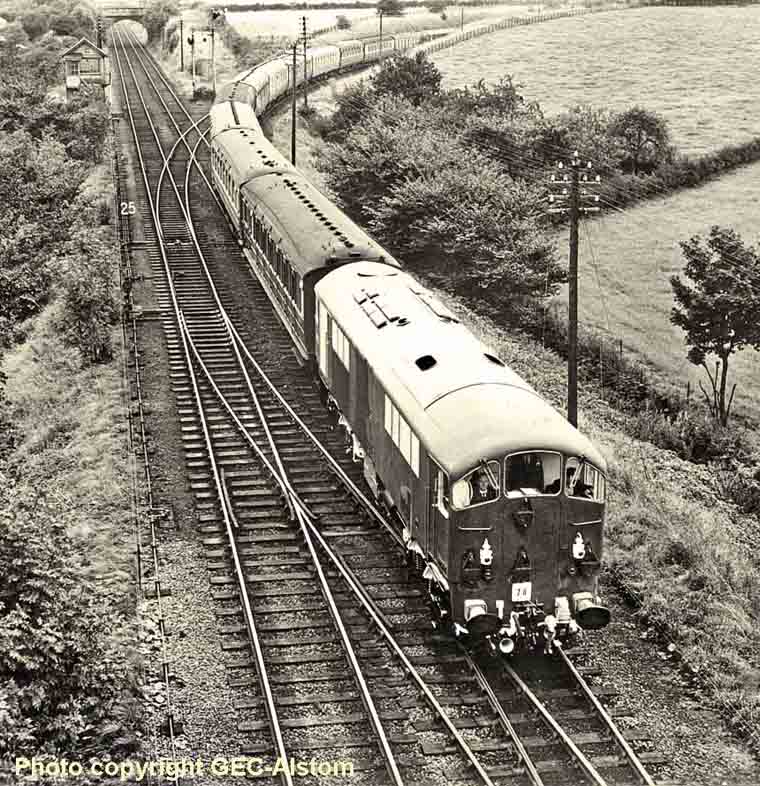
(Above) The first of the twenty pilot scheme Metro-Vick Co-Bos No D5700, began trials on 7 July 1958, taking a 14-coach train from the Stockton works to Leeds via the steeply-graded Wetherby route. Still in workshop primer (and sporting an express passenger headlamp code on the front end) No D5700 heads past Wetherby West Junction on the return working to Teesside. The Wetherby route was used for controlled road tests of the EE Co Type 1s and Type 3 built at Darlington.
(Below) On October 1st 1958, the first of the Metro-Vick Co-Bos Nos D5700 and D5701 hauled a train comprised of 25 fitted 'plateflats' from Hendon to Glasgow in order to evaluate their capabilities when working as a pair on a new 'Condor' over-night freight service. The Condor (an abbreviation of container door-to-door) was one of the first attempts at container freight traffic in Britain, and made its inaugural run on March 16th 1959, its main attraction being a guaranteed overnight delivery between Hendon, London and Gushetfaulds in Glasgow. Prior to its introduction, tests were carried out under controlled trial conditions, comprised of a dynometer coach and 25 short wheelbase vacuum braked flats. The test train is seen at Skipton. © GEC-Alstom 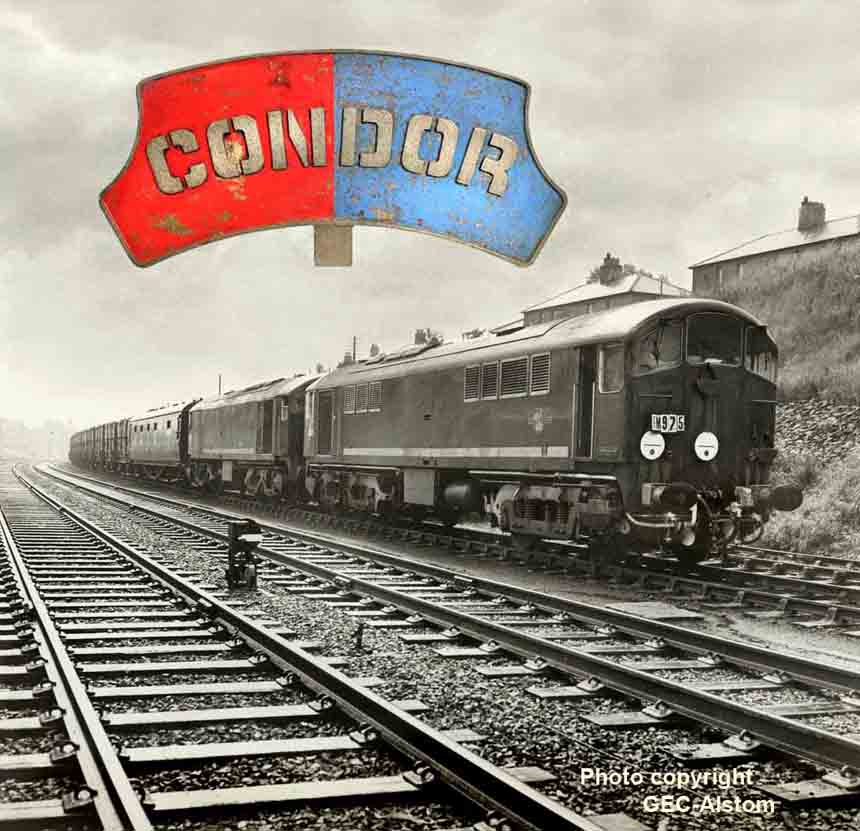
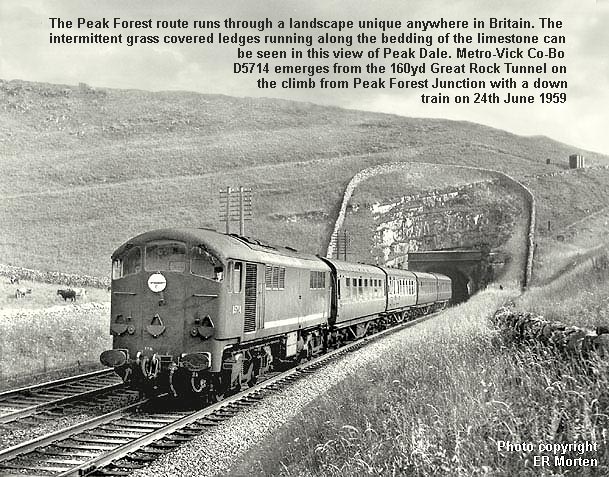
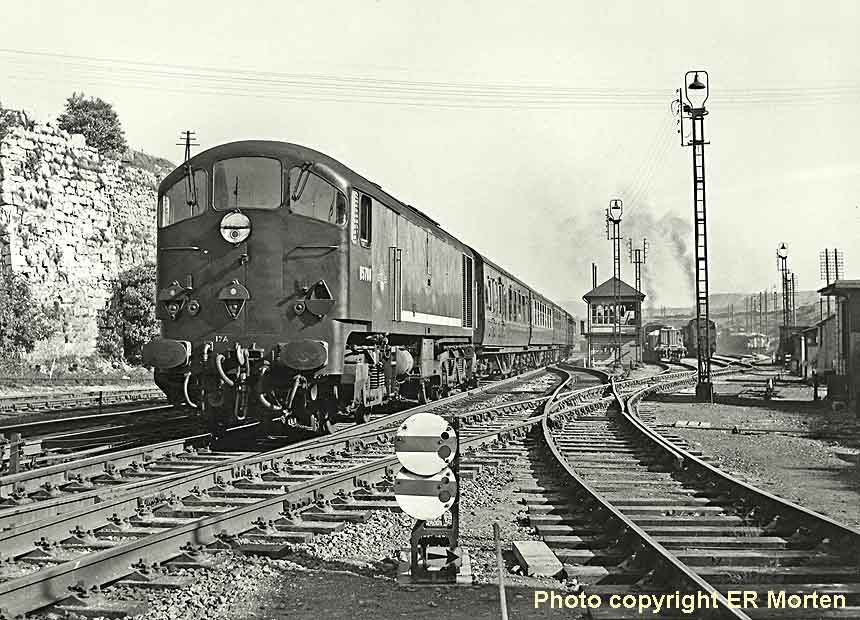
(Above-Below) Back in the early 1960s, visits to the lineside were primarily intended to photograph the elderly statesmen of steam before they vanished from the scene entirely, therefore the early diesels were largely ignored, but with the passing of years the interest in photographs of diesels is on a par with those of steam. A good example are ER Morten's classic shots of Metro-Vick Co-Bos at work on the MR main line between Derby and Manchester. Despite the Co-Bo's dubious reputations, the Co-Bos were revered by a large number of enthusuasts, no doubt as a result of their relatively few numbers - Nos D5700-D5719 - twenty in all. They had a distinctly box-shaped body mounted on an unusual Co-Bo wheel arrangement; the cabside doors were windowless, and those on the drivers side were located some distance behind the cab itself. The Metro-Vick fleet may have been undistinguished machines, but ER Morten still recorded their activities on the route. (Above) No D5700 heads a 'down' train at Peak Forest on June 14th 1959. Peak Forest Summit (985ft) is situated in a deep cutting culminating with the entrance to Dove Holes Tunnel. Here, No D5706 heads an 'up' train out of the tunnel on August 18th 1959. Both: © ER Morten
(Above) Until sufficient numbers of the larger and more powerful Type 4 'Peak' class locomotives became available to the operating department, the twenty troublesome Metro-Vick Type 2s were a regular sight on the MR main line between Manchester and Derby.The fleet was allocated to Derby 17A, but after a short period in service, their Crossley power units developed problems on a large scale and the class was put into store, awaiting a decision on their future. Smoking badly - a characteristic fault of the Metro-Vick Co-Bos - Nos D5705 and D5714 head a 'down' express at Great Rocks Junction on June 16th 1959. 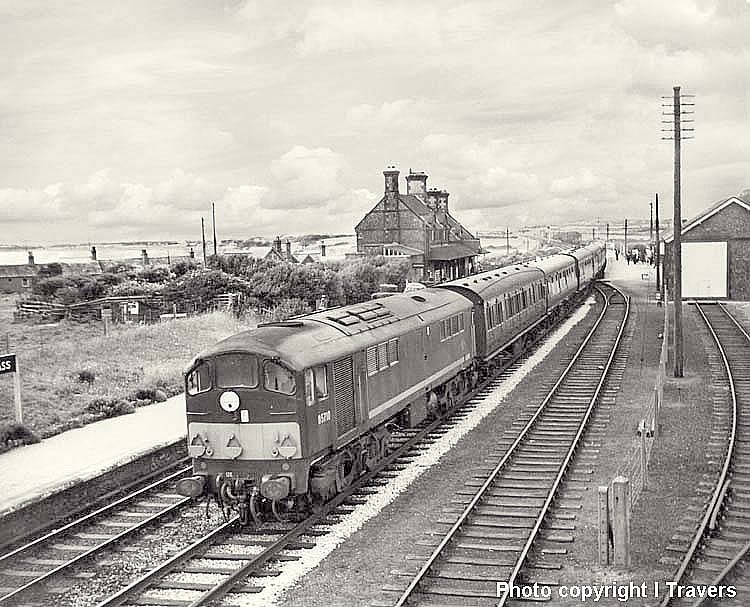
(Above-Below) Following refurbishment at the manufacturers works at Dukinfield, the fleet was eventually assigned to work secondary passenger and freight duties in the Furness and West Cumberland areas of the MR, all based at Barrow, but with a few sub-shedded to Workington operationally. D5714 heads the morning Workington-Barrow train at Ravenglass in August 1962. (Below) The doyen of the class, D5700, heads a local train at Hest Bank.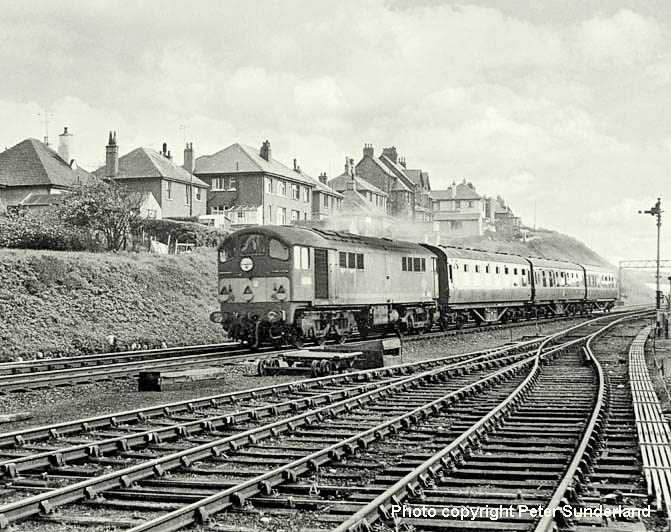
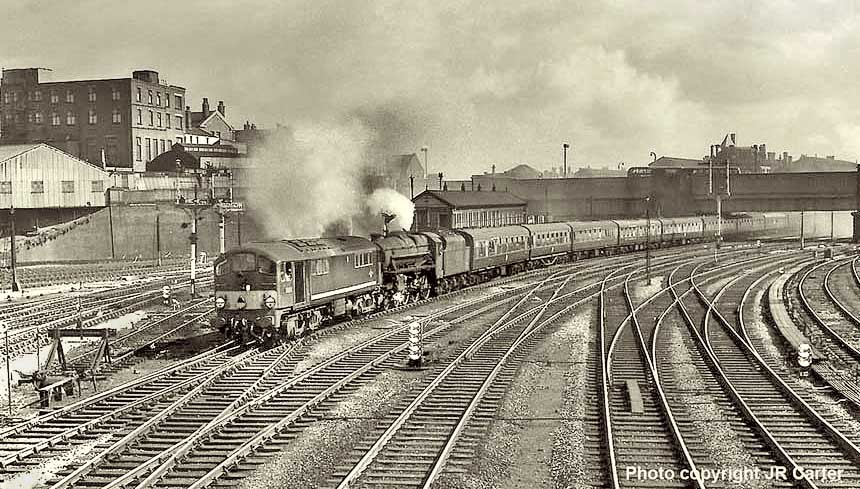
(Above) The signal gantry at Preston provided 'Footplate Cameraman' Jim Carter with this elevated view of Metro-Vick Co-Bo No D5701 and an unidentified Black 5 (called upon to provide steam heating for a Manchester-Blackpool working) on the climb out of Preston station in June 1960. During steam days, a double-header (a combination of steam locomotives coupled together) was often used, but with the onset of dieselisation a pair of locomotives coupled together and worked by one driver became known as multiple workings, whereas diesels coupled together and driven independently were called tandem workings. The use of a steam/diesel combination was discouraged by the operating department, but when this could not be avoided it was obligatory for the steam locomotive to be coupled inside to prevent the risk of hot ashes dropping from the leading engine which could ignite the accumulative oil deposits on the underside of the trailing diesel - plus there was a risk of coal tumbling from a tender and smashing the windscreen of a trailing diesel.
(Below) For those mourning the demise of the Metro-Vicks are reconciled with the thought that at least one (No D5705) is still in existence and undergoing restoration. The locomotive survived thanks to it being taken out of stock by BR's Derby Research Unit in January 1969. It spent many years as a carriage heating unit on the Western Region before finally being rescued for possible preservation. This July 1962 shot shows D5705 at Lake Side station, terminus of the Furness Railway's branch from Ulverston to Lake Windermere which closed on 6th April 1964. A lovely name and an idyllic setting, now the terminus of the Lakeside and Haverthwaite Railway.
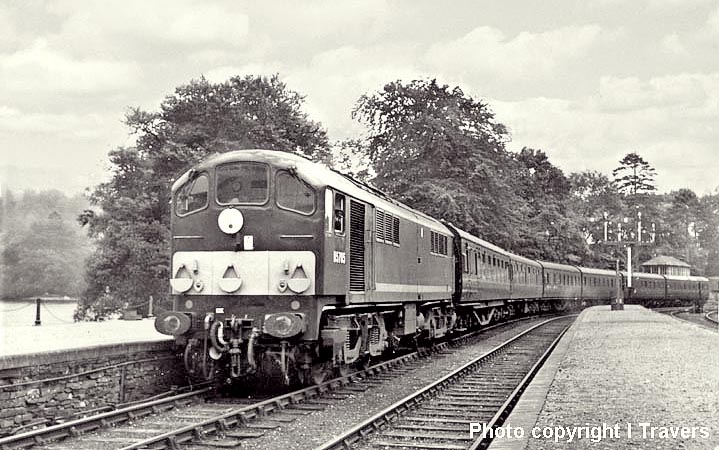
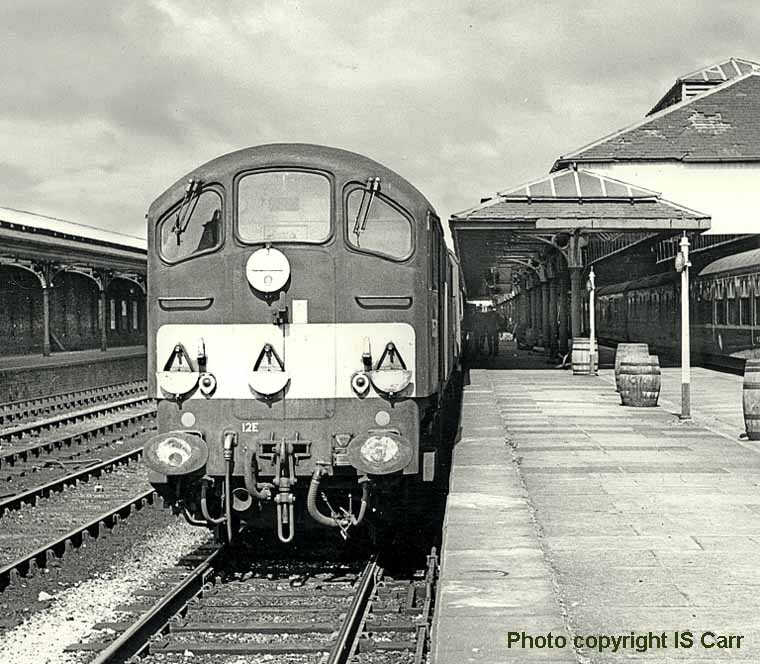
(Above-Inset) The original wrap-round windows were a neat detail design of the Co-Bos, but these were later replaced by a flat screen mounted in rubber mouldings to reduce maintenance costs. The modification 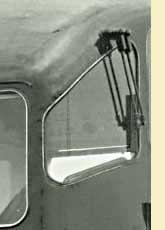 can be seen in this view of No D5701 awaiting departure from Workington with the 15.12 to Liverpool Exchange on August 14th 1963. Photo: © IS Carr
can be seen in this view of No D5701 awaiting departure from Workington with the 15.12 to Liverpool Exchange on August 14th 1963. Photo: © IS Carr
(Below) Although the reliability of the Co-Bos saw an increase in availability figures, the rationalisation of the traction fleet had already been decided upon and the early withdrawal of the class was inevitable. The end of the Co-Bo saga is epitomised in this view of Nos D5712/17 on the scrap line at Carlisle New Yard on April 2nd 1969. At the same time, eleven of the ill-fated class awaited disposal: Nos D5701/2/6-8/11/12/14/16/17/19. Following withdrawal in the first week of September 1968, the locos were stored inside the old Kingmoor steam shed 12A, then moved to Carlisle New Yard in February 1969, where they remained until departure for scrapping at J Cashmore of Great Bridge the following Autumn. The locomotives left in the following convoys; September 15th D5701/2/6; September 16th D5707/8/11; September 17th - D5716/17 and Nos D5714/19 left on September 18th. For some reason No D5712 did not go until November, then it too made its last journey for scrapping. Also stored at Carlisle was a large group of Clayton Type 1s in the D8500-34 number series. Some of the Claytons were subsequently reinstated for further service in Scotland. For the record, D5701 was the only Co-Bo to receive the BR blue livery at Crewe works in 1967. Photo (and full caption details) © A Whitaker 
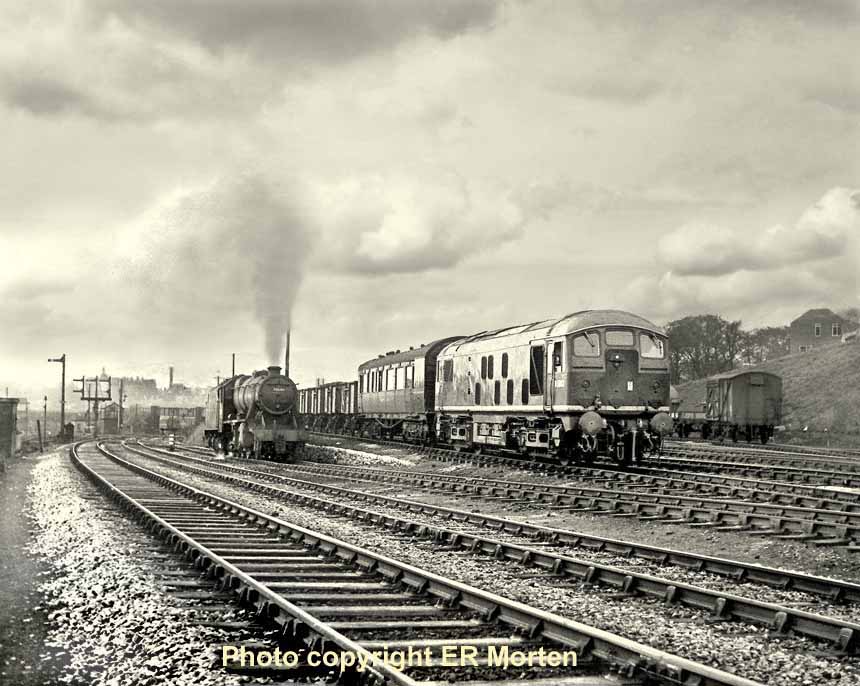
(Above) There is no doubt, that had the LMS existed during the 1950s, they would have firmly approved of the new Bo-Bo Type 2 diesel, as it was a natural successor (or diesel equivalent) to the medium-powered Class 4F 0-6-0 steam locomotive. Here, two classic examples of rail traction old and new: - a Stanier Class 8F 2-8-0 No 48680 and BR/Sulzer Type 2 No D5083. The diesel is standing in Buxton 'down' siding pending resumption of braking tests over the Peak Forest line.
(Below) To evaluate the performance of the early diesels, the BTC carried out an extensive road test programme using three mobile test units which could absorb the power being developed while maintaining a selected speed. On June 23rd 1959, it was the turn of pilot scheme Type 2 Bo-Bo No D5008, seen here passing the newly-opened Buxton depot before resuming trials over the Peak Forest route. With a ruling gradient of 1 in 90-100 from Rowley to Peak Forest, the MR line was a favourite test route for new locomotives built at Derby. The diesel depot at Buxton closed on 12 October 1997. Photos: © ER Morten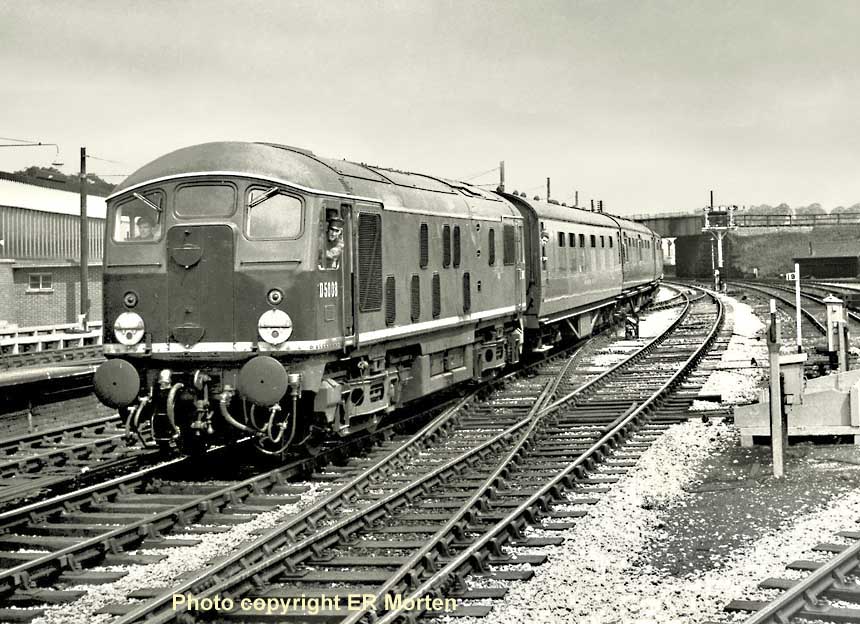
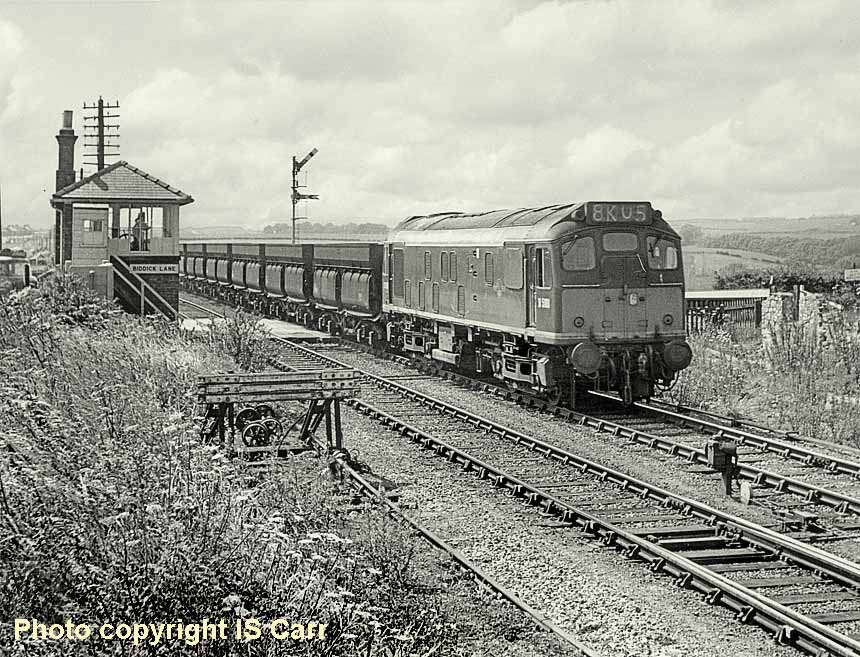
(Above) The Type 2 Bo-Bos were widely travelled throughout the BR network. One notable allocation was to Gateshead to displace the BR Standard Class 9F 2-10-0s on the iron ore trains from Tyne Dock to Consett. The ore was carried in special high-capacity hopper wagons run in trains of fixed length with automatic loading and unloading at terminals. The hoppers have air-operated doors, for which the Type 2s acquired an extra compressor and hose connection. Here, No D5181 passes Biddick Lane crossing on the former Stanhope & Tyne line with iron ore empties for Tyne Dock on 10 July 1966. Photo © IS Carr. (Below) Pilot Scheme Bo-Bo No D5019 heads an 'up' train at Peak Forest Junction 3rd September 1959.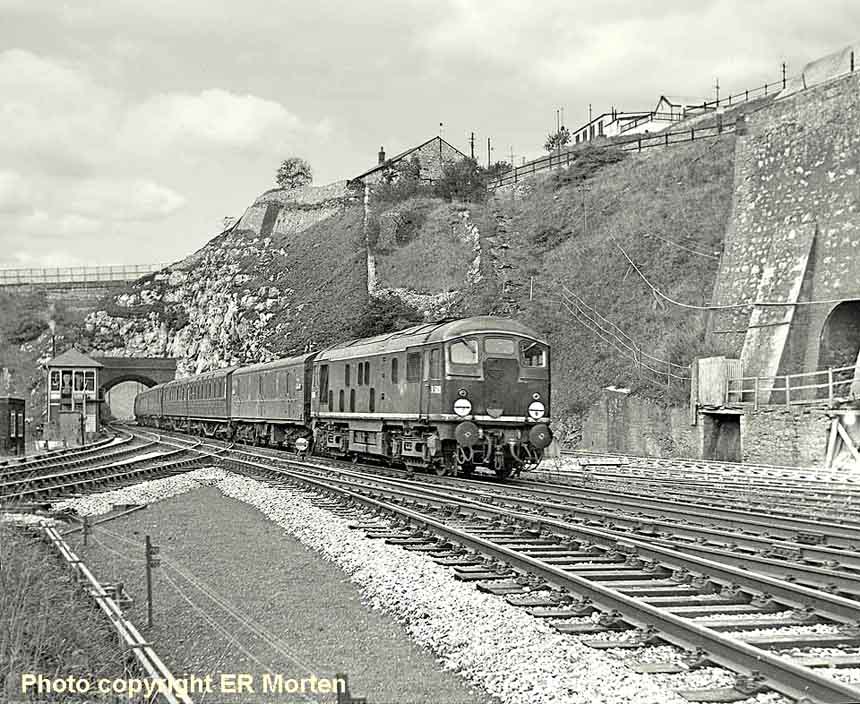
(Below) With such large orders in prospect, Derby, Crewe, and Darlington works all shared in the construction of the Type 2, together with the Beyer Peacock works at Gorton, Manchester. When the production was eventually completed in 1967, no less than 478 Type 2s had been built. The Scandinavian boat train to and from Tyne Commission Quay was worked out of Newcastle by BR/Sulzer Type 2s. In pouring rain, No D7593 runs round the stock of the 14.33 boat train from Newcastle on April 26th 1969. It will haul the stock to Heaton carriage sidings setting down any passengers at Walker Gate to continue their journey by DMU. 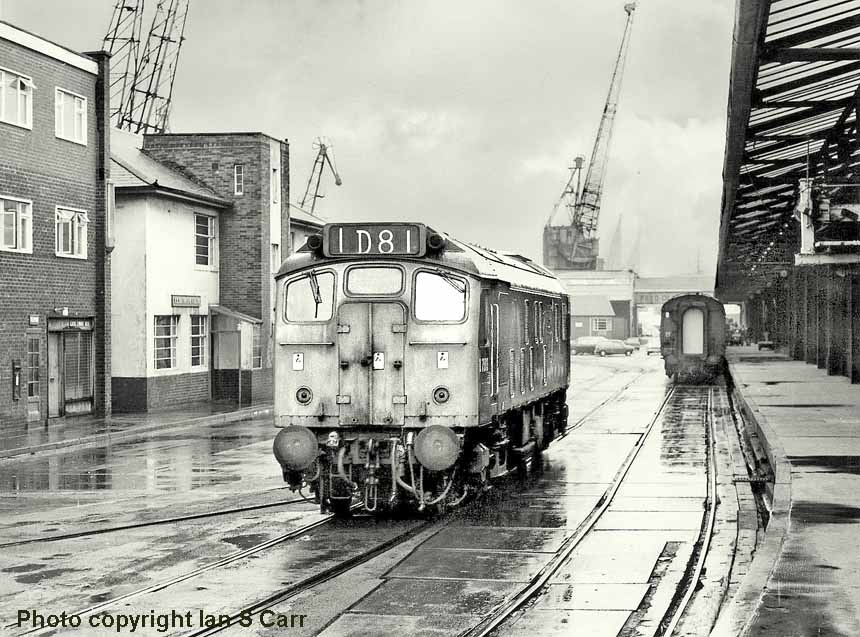

(Above) With the onset of modernisation, the BTC was trumpeting facts on how diesel and electric traction would be immeasurably cleaner than steam, whereas in reality the diesels had to work in uncomfortably-close proximity with steam, therefore the fleet ended up just as filthy as its predecessors and maintenance problems arose from the lack of cleanliness. Many factors can contribute to the general discoloration of paintwork, notably the inorganic dust originating from brake shoes which can quickly spread itself as an even layer from rail level upwards. Another factor that caused the discolouration of paintwork was the amount of oil seepage from engine compartments which can attract dirt very quickly and eradicate any semblance of a locomotive livery. Already looking worse for wear, BR/Sulzer Type 2 No D5080 stands alongside Black 5 No 45156 Ayrshire Yeomanry at Patricroft shed. Photo © JR Carter.
FOOTNOTE: The Internet is a major source of reference that attracts thousands of railway enthusiasts every day, either to research a subject or to bring with them their own diverse interests and expertise; indeed the subject of Britain's railways is extremely complex and so it is essential to get the facts right. One very helpful contributor to this site is ex-BR Fleet Engineer, Vic Smith, who writes - 'The white discolouration found at the No 1 end of the locomotive was due to overflowing coolant which had been treated with a Borax/Metasilicate inhibitor...'
(Above-Below) Due to the hasty abandonment of the pilot scheme orders and subsequent quantity production of the new diesels, construction of the BR/Sulzer Type 2 produced many changes before a satisfactory design was finally evolved. Nos D5000-D5150 (later TOPS Class 24) were powered by the Sulzer 6LDA 1,160hp engine whereas the production locomotives numbered from D5151 upwards (later TOPS Class 25) were fitted with the uprated 1,250 Sulzer engine, but externally retained the original bodystyle except for roof-mounted headcode boxes in place of the aged headcode disc system. (Above) D5128 awaits departure from Inverness with 'The Orcadian' for Thurso. Note the ScR hase fitted brackets onto the handrails either side of the gangway door to allow the named train headboard to be carried. (Below) Hidden under the grime of No D5224 (heading a Morecambe-Leeds train near Newlay and Horsforth) is a two-tone green livery.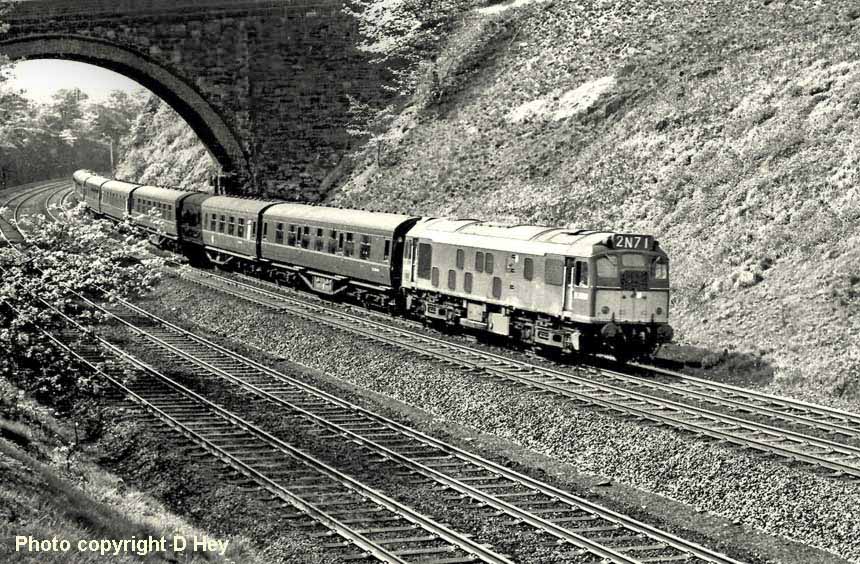
(Below) The clutter of engine room ventilation louvres on the BR/Sulzer Type 2 was a poor design feature as they allowed dirt to enter the engine room. The final, completely revised Type 2 design had the air intake grills re-sited at cant rail height and the removal of the draughty gangway doors enabled the centre windscreen to be revised. Still retaining its two-tone green livery but sporting full yellow ends, No D7513 awaits its next turn of duty as banker on the 1-in-47 Miles Platting bank out of Manchester Victoria in 1968. 

(Above-Below) Built by the Birmingham Railway Carriage and Wagon Company, the 20 pilot scheme 1,160hp Type 2s were originally allocated to the ER London area based at Hornsey 34B. No D5318 was photographed there on February 20th 1959. (Below) In May 1961, Aviemore shed plays host to No D5340, one of 46 locomotives Nos D5300-D5346 (including the pilot scheme machines) allocated to the Scottish Region, and designated Class 26 in the TOPS reclassification scheme. The class was painted in dark green with the cab window area picked out in off-white. 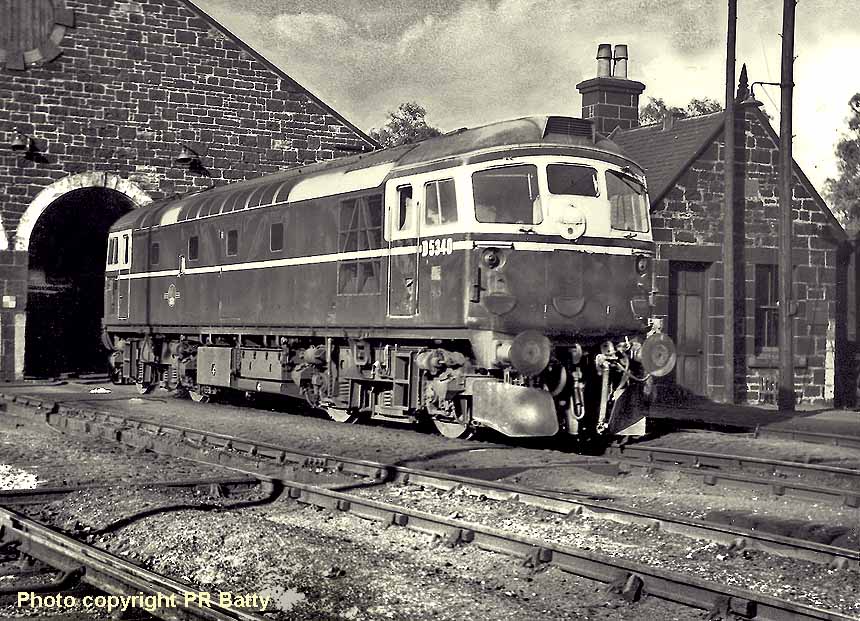
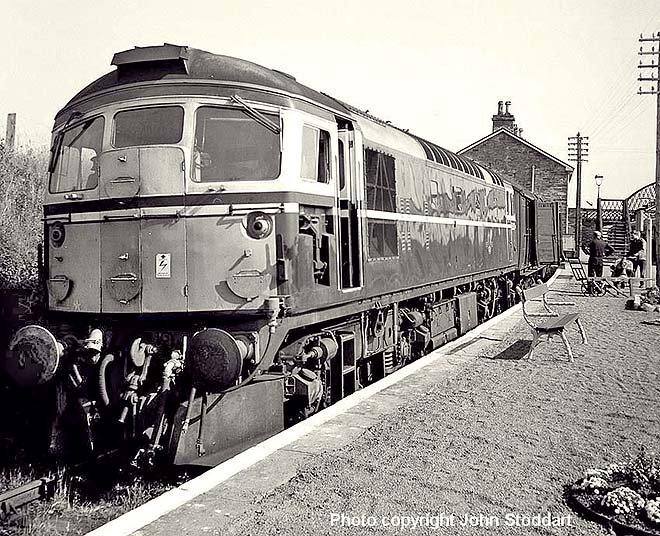
The ScR modifications included the fitting of sliding cabside windows and a single line tablet catcher fitted into the recess of the cab, both modifications clearly seen in this view of a BRCW Type 2 in the bay platform at Georgemas Junction. The success of the design led to an order for Nos D5347-D5415 in the fleet, with their engines uprated to 1,250hp, later TOPS Class 27, and externally they were fitted with roof-mounted four-digit route indicators in place of the aged marker discs.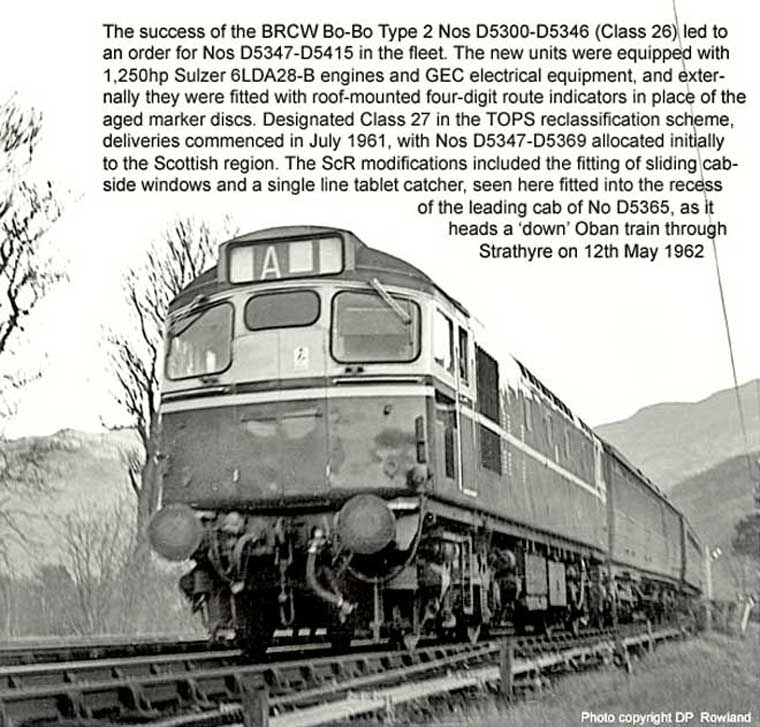
Photo
(Above-Below) In an attempt to rationalise the use of different diesels in different areas, the ten North British Loco Co's pilot-scheme Type 2 Nos D6100-9 (allocated initially to Hornsey for working Kings Cross suburban services) were transferred to the ScR in April 1960. They were accompanied by the BRCW's ten pilot-scheme Type 2s D5300-D5309, joining the first production models which had arrived on the ScR during May the previous year for working Edinburgh-Aberdeen services. During manufacture of the NBL Co Type 2, the makers utilised some original tools and aluminium castings devised for the company's earlier pilot-scheme 'Warship' class A1A-A1A's Nos D600-D604, which led to the rather odd front-end shape of the D6100s - odd, because the driver's visibility was impaired by the accentuated curve of the cab windows which were designed to accommodate the central gangway door in the nose end (as stipulated by the BTC to allow crew movement between locomotives when working in multiple). Eventually all the NBL Type 2s were transferred to Scotland. (Below) No D6149 at Kittybrewster shed, Aberdeen.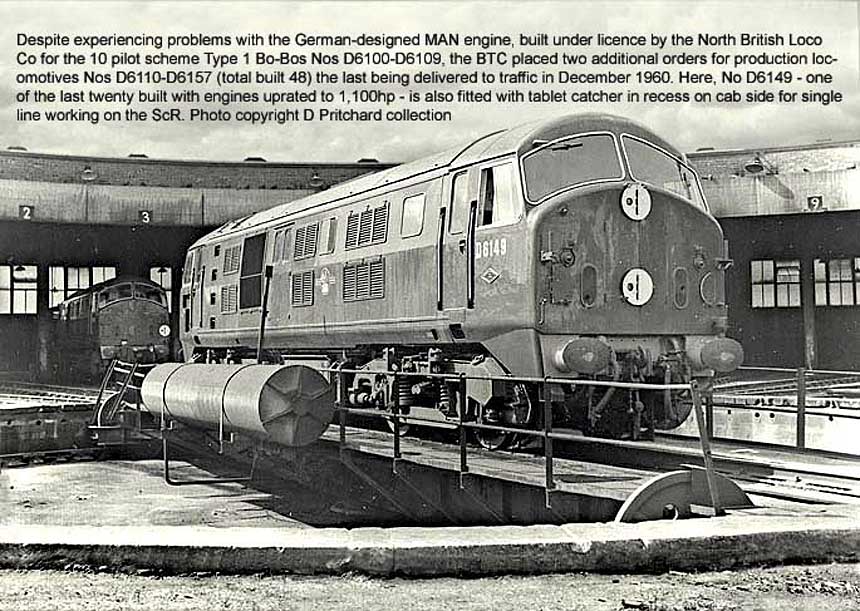
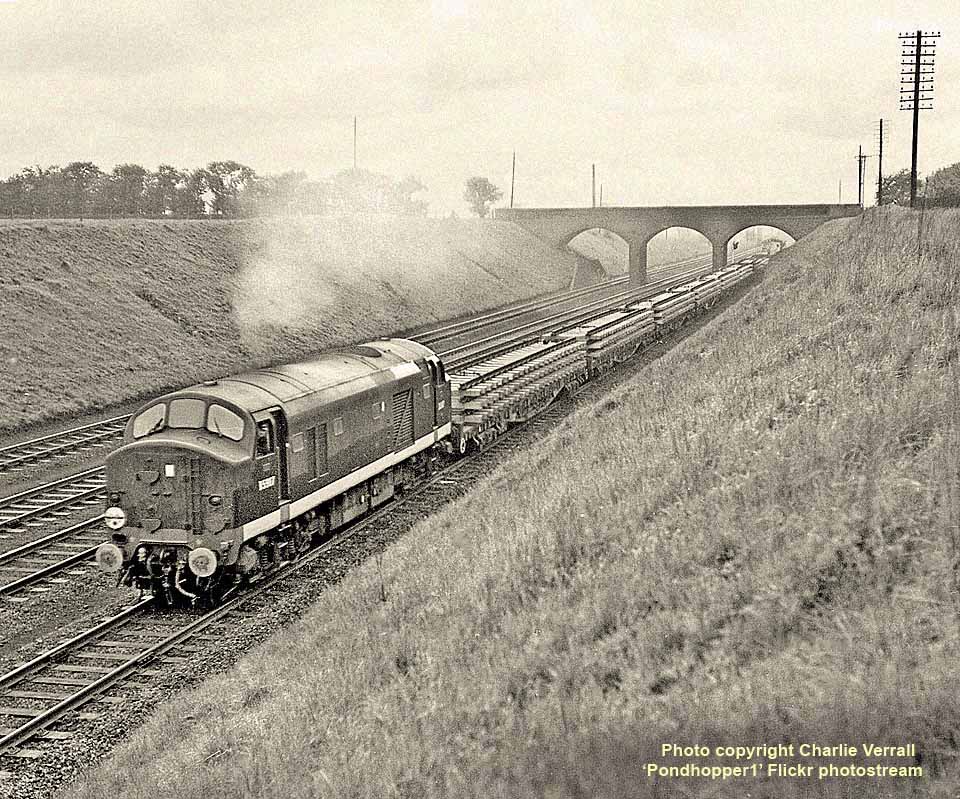
(Above-Below) Introduced in 1959, the EE Co's candidate for the Type 2 power range turned out to be one of the pilot scheme's biggest failures. When the rationalisation of the diesel fleet was announced, the ten troublesome 1,100hp 'Baby Deltics' Nos D5900-D5909 based at Finsbury Park for Kings Cross outer suburban services, were one of the first to be withdrawn. The availability of the class was marred by recurring failures of their Napier T9 29 power units. Despite carrying out a costly engine refurbishing programme at the EE Co works, the ten locomotives never quite lived up to their more illustrious cousins in the company's diesel range and the entire class was withdrawn by March 1971. This photograph of D5907 heading an engineers train at Hitchin on May 12 1962 was taken by Rail Cameraman, Charlie Verrall - check out his page 38 on the left-hand menu; No D5907 emerged from the EE Co works in May 1959 and became one of the earliest candidates for withdrawal in October 1968. (Below) No D5907 is featured again, this time heading a Cambridge-Kings Cross train in December 1959. Site visitor, Simon Harding, has kindly identified the location as Welwyn Garden City, his local station. His attention was instantly drawn to the gallows type signal which was a feature of the station up until resignalling of the ECML in the early 1970s. The architecture of the shops on the station approach (left of picture) is also quite distinctive. The train is crossing from the up slow platform back on to the main. Thanks Simon, I recall similar GNR signals at Leeds Central station.
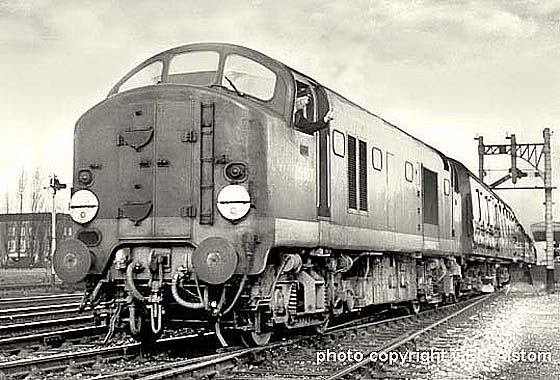
Polite notice: All text and photographs are protected by copyright and reproduction is prohibited without the prior consent of the © owners. If you wish to discuss using the contents of this page the email address is below. Please note - this is not a 'clickable mail-to link via Outlook Express:
dheycollection@ntlworld.com


